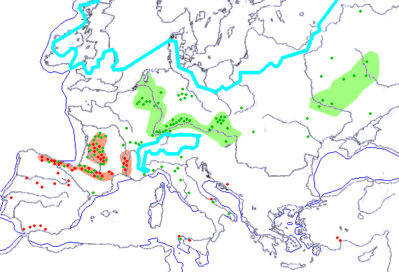So where is Isturitz, what is Magdalenian, what the heck are you talking about?
Ok, let's recapitulate:
1. A week ago, I commented on Aurignacian origins. Aurignacian culture is believed to be the first manifestation of Homo sapiens (we and our ancestors) and it's known to have penetrated pretty fast in most of Europe, displacing the former inhabitants, the Neanderthals. I also posted a map by A. Mellars:

Aurignacians began experimenting with rudimentary art and eventually also colonized, even if sparsely, the Mediterranean shores of the Iberian peninsula.
2. Haven't yet posted on it, I think, but the next thing to happen, many thousand years later was the developement or arrival of Gravettian culture. Gravettian technology shows some correlation with Neanderthal-made Chatelperronian but it's also true that similar technologies were in use among West Asians and possibly other peoples. Earlier, when Paleolithic research was concentrated in France, it was thought that Chatelperronian and Gravettian were two phases of the same cuture (Perigordian) but this is not sustained anymore and now it's believed that Gravettian culture evolved in Central-Eastern Europe or even arrived from outside the continent (though there's lack of evidence for this yet). It is likely that the Crô-Magnon type, strictu sensu, is associated with this culture.
Gravettian is also a pan-European culture and replaced Aurignacian everywhere, even if in many places it looks intrusive (older techniques remain). In fact it reached further than Aurignacian, incorportaing Eastern Europe and even penetrating into the Caucasus and Zagros areas (West Asia) and with connections as far east as the Altai. With Gravettian art became something much more common. Some of the most fascinating examples are the venus figurines, like the one of Lespuges:

3. In Western Europe, Gravettian didn't last long alone. A new techno-culture appeared locally, the Solutrean and replaced Gravettian rather fast, specially in the Franco-Cantabrian region. Instead, in Mediterranean Iberia, Gravettian showed to be strong enough and survived in a hybrid form with Solutrean (Iberian Gravetto-Solutrean), that is probably at the origin of North-African Ibero-Maurusian culture later on.
Solutrean was therefore primarily a culture of the Franco-Cantabrian region:

The Franco-Cantabrian region
(red dots are main sites of Paleolithic art, light green are areas that were over sea level in the past, white shows glacial areas).
(red dots are main sites of Paleolithic art, light green are areas that were over sea level in the past, white shows glacial areas).
Gravettian also survived in Italy and Eastern Europe. Central Europe is believed by many to have been too cold to be inhabited, at least densely, in this time, as the Solutrean phase is coincident with the Last Glacial Maximum, some 20,000 years ago. Another area that was affected by this episode was the Zagros region of West Asia, where human inhabitation probably became impossible or very hazardous then.
Solutrean peoples were very advanced for their time, knowing the needle, the fishing hook and maybe even the bow and arrow. They also advanced quite a bit in art expression.
4. After some milennia, Solutrean evolved into Magdalenian locally in the Franco-Cantabrian region. While many sites with transitional industries are known, there are some questions still to answer because the Magdalenian is surprisingly similar to old Aurignacian, even if much more refined. Since c. 13,000 BP, as the greatest cold went away, Magdalenian expanded into Central Europe. It also shows signs of late expansion into Mediterranean Iberia but with a very marked Gravetization anyhow (Parpalloan) and lacking the characteristic bone tools of this industry elsewhere.
Magdalenian is, of course, best known for its magnificient mural art, though these peoples also made potable art, like their predecessors.

Horse from Lascaux cave (Franco-Cantabrian region)
And here is where the Isturitz findings fit in: Magdalenian, Franco-Cantabrian, bone tools... whale bone tools! Makes sense, right?
Where is Isturitz? Quick graphic answer:

Is that better? Hope so.
Another interesting map is this one of European Paleolithic art:

Red: mural art. Green: portable art.
Cyan thick lines: glacial maximum: areas under ice. Blue lines: ancient coastline.
It helps getting an idea of where did humans dwelt in the Upper Paleolithic. Yet the Mediterranean, even if not so dedicated to art as other areas, also had some population density probably.










2 comments:
Sources?
Sources of what? Be specific. Some are clear if you follow the links.
Post a Comment